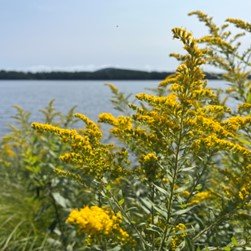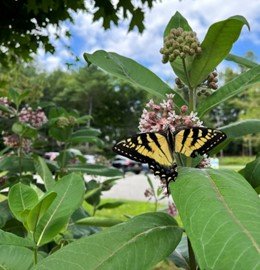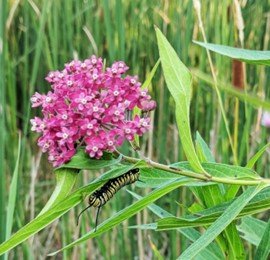What is a Rain Garden?
With the heavy rainfall and multiple flood events in the Adirondacks and surrounding areas this spring and summer, you may find yourself thinking about how large volumes of stormwater are managed more than you have in the past. Maybe a washed-out road prevented you from getting to work, maybe your basement flooded, or maybe you’ve noticed more trash and debris than usual in your local pond or stream. Due to climate change, and because warmer air can hold more moisture, we have experienced more frequent and intense precipitation events in the past 30 to 40 years, and it's likely that this pattern will continue in the years to come.
So, what can you do to help protect yourself, your community, and the waterbodies you reside by? One option is to consider planting a rain garden.
What is a rain garden?
A rain garden, in the simplest sense, is a garden that serves the purpose of catching and temporarily holding rainwater, giving it the chance to permeate the soil and recharge the groundwater supply. This diverts and delays some of the runoff from entering storm drains and flowing into a nearby body of water without being filtered or treated in any way. More specifically, a rain garden should be planted in a fairly flat and low area positioned to capture runoff downslope from roofs, driveways, streets, and other impervious surfaces. Ideally, a rain garden will consist of native plant species with deep, strong root systems.
Why are rain gardens important?
Rain gardens have the ability to act as temporary water-holding basins and filters for stormwater. Similar to how a wetland functions as a floodplain, a rain garden can temporarily hold excess water in your yard. Once runoff collects at a rain garden, depending on the quantity, it can begin to permeate the soil as soon as it enters the garden or after pooling. Runoff often contains pollutants such as fertilizers or herbicides and sediment. The root systems of plants can catch and hold sediment in place and can chemically absorb pollutants in the runoff which can then be used by the plants as nutrients and converted into less harmful chemical forms.
If the water were to continue flowing into a storm drain without passing through a rain garden or other vegetated area, it would take all of the pollutants, sediment, and nutrients along with it and deposit them into a body of water. This could potentially cause problems in the body of water it flows into; nutrient overload could cause excessive growth of algae, leading to hypoxia (oxygen depletion), or excessive growth of cyanobacteria (also called blue-green algae) which has the potential to cause harmful algal blooms that release toxins.
How can you build one?
To build a rain garden, you’ll want to follow a few steps:
Choose an ideal location
You'll want your rain garden to be at least 10 feet downslope from your house’s foundation so that it doesn’t contribute to flooding or erosion. Some locations to consider are somewhere that intercepts the flow of rainwater from your rain gutter or roof, upslope from a storm drain if one is nearby, or in a naturally low spot that does not already fill with standing water.
Build the garden
Whether you have an area of land that already has a naturally formed depression or not, here are some details to consider when building your garden:
The slope of the garden itself should be fairly flat so that the water flows slowly enough that it has a chance to soak into the ground.
The garden should ideally be longer than it is wide to allow maximum surface area for the water to flow over and soak into.
The soil in your rain garden should be well-draining. If you don’t already have well-draining soil, you may need to remove 6-8 inches of soil and replace or mix it with well-draining soil containing a higher percentage of sand.
Choose your species
Since native plants have strong root systems that help stabilize soil and require the least amount of maintenance in their natural environment, they are the ideal plants for a rain garden (and for your yard in general!). By planting native plants, we also add to the biodiversity of our ecosystem by encouraging native pollinators. Native pollinators, such as many species of insects (including, but not limited to bees), birds, and bats, have evolved alongside native plants, meaning that our native plants are the ideal resource for native pollinators, whether they are acting as a food source, host plant, or shelter.
Different plants provide different benefits: trees and shrubs are good at deflecting rainwater to slow it down before it reaches the ground, grasses are particularly good at absorbing water and pollutants and at preventing sediment from being carried downstream, and shorter deeply rooted plants hold soil in place and direct water into the ground. To find out what plants are native to your area, you can search for your location in the National Audubon Society’s Native Plants Database. Examples of plants native to Paul Smiths, NY include (as seen in order below) Canada goldenrod (Solidago canadensis), common milkweed (Asclepias syriaca), swamp milkweed (Asclepias incarnata), and common yarrow (Achillea millefolium).
Additional benefits
In addition to filtering out pollutants and sediment, replenishing the groundwater supply, acting as a small-scale floodplain, and providing habitat and resources for native pollinators, rain gardens also add to the aesthetic appeal of your yard and provide an example of ecological stewardship that can encourage similar action amongst other community members.
Rain gardens can vary in size and complexity. No matter the size or intricacy of yours, planting a rain garden is a great way to contribute to a clean and healthy watershed.




